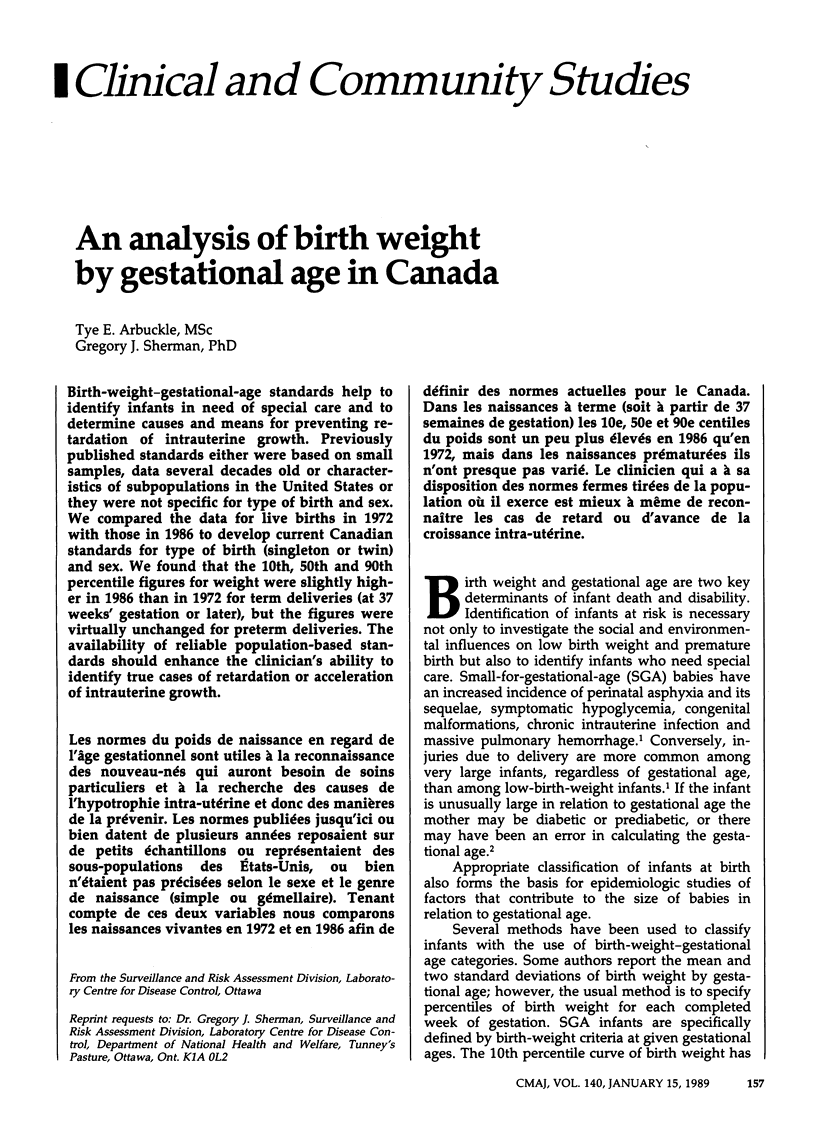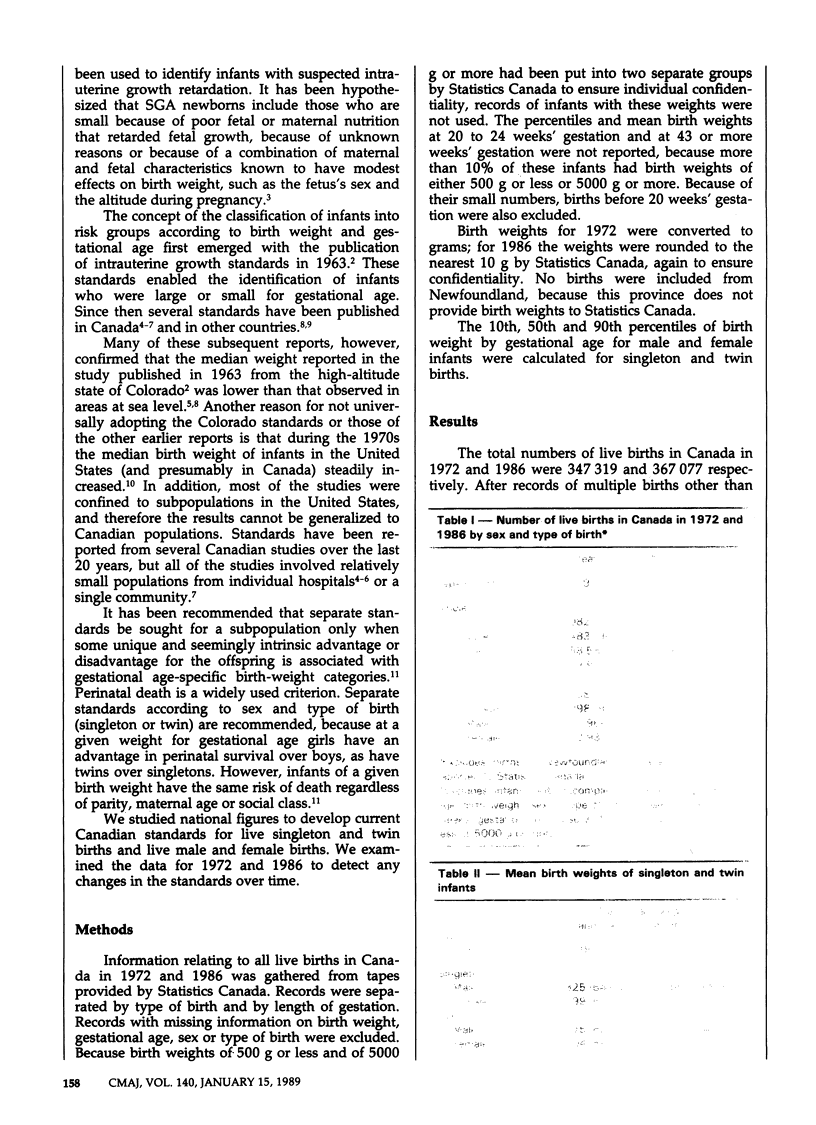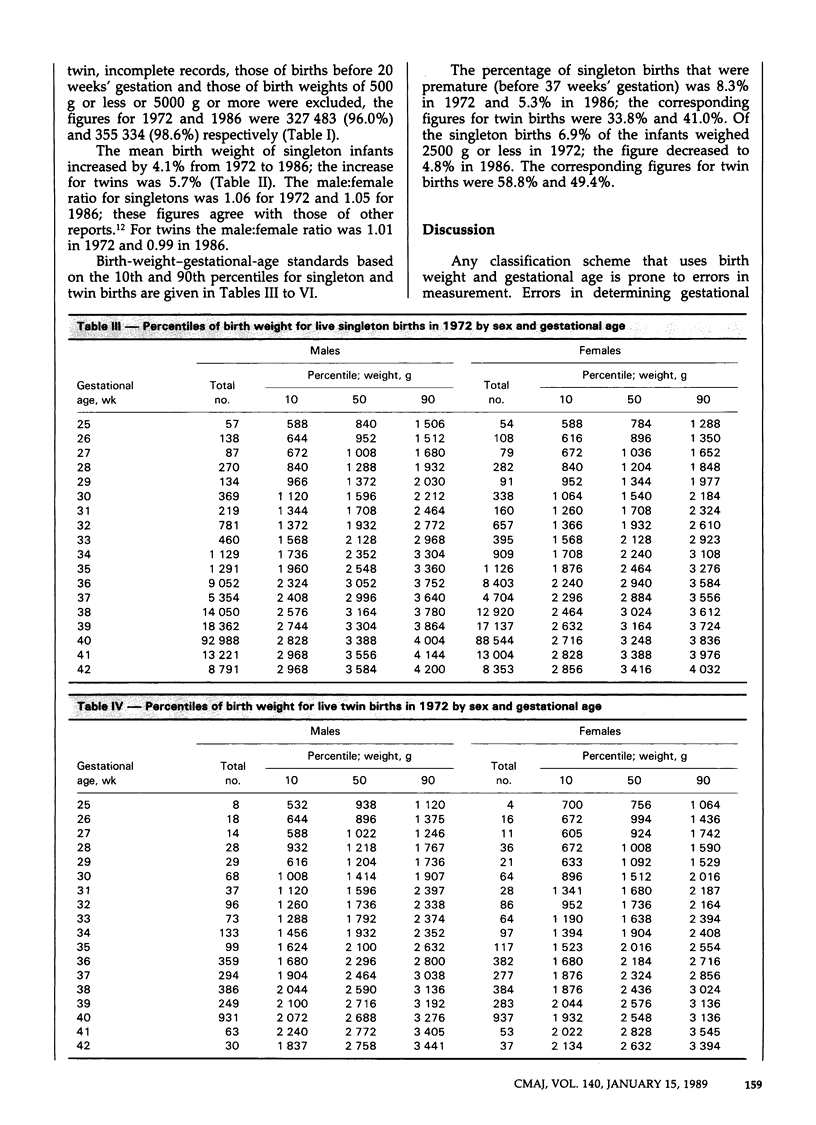Abstract
Birth-weight-gestational-age standards help to identify infants in need of special care and to determine causes and means for preventing retardation of intrauterine growth. Previously published standards either were based on small samples, data several decades old or characteristics of subpopulations in the United States or they were not specific for type of birth and sex. We compared the data for live births in 1972 with those in 1986 to develop current Canadian standards for type of birth (singleton or twin) and sex. We found that the 10th, 50th and 90th percentile figures for weight were slightly higher in 1986 than in 1972 for term deliveries (at 37 weeks' gestation or later), but the figures were virtually unchanged for preterm deliveries. The availability of reliable population-based standards should enhance the clinician's ability to identify true cases of retardation or acceleration of intrauterine growth.
Full text
PDF




Selected References
These references are in PubMed. This may not be the complete list of references from this article.
- Babson S. G., Behrman R. E., Lessel R. Fetal growth. Liveborn birth weights for gestational age of white middle class infants. Pediatrics. 1970 Jun;45(6):937–944. [PubMed] [Google Scholar]
- Blidner I. N., McClemont S., Anderson G. D., Sinclair J. C. Size-at-birth standards for an urban Canadian population. Can Med Assoc J. 1984 Jan 15;130(2):133–140. [PMC free article] [PubMed] [Google Scholar]
- Brenner W. E., Edelman D. A., Hendricks C. H. A standard of fetal growth for the United States of America. Am J Obstet Gynecol. 1976 Nov 1;126(5):555–564. doi: 10.1016/0002-9378(76)90748-1. [DOI] [PubMed] [Google Scholar]
- David R. J. Population-based intrauterine growth curves from computerized birth certificates. South Med J. 1983 Nov;76(11):1401–1406. doi: 10.1097/00007611-198311000-00020. [DOI] [PubMed] [Google Scholar]
- Kessel S. S., Villar J., Berendes H. W., Nugent R. P. The changing pattern of low birth weight in the United States--1970 to 1980. JAMA. 1984 Apr 20;251(15):1978–1982. [PubMed] [Google Scholar]
- LUBCHENCO L. O., HANSMAN C., DRESSLER M., BOYD E. INTRAUTERINE GROWTH AS ESTIMATED FROM LIVEBORN BIRTH-WEIGHT DATA AT 24 TO 42 WEEKS OF GESTATION. Pediatrics. 1963 Nov;32:793–800. [PubMed] [Google Scholar]
- Milner R. D., Richards B. An analysis of birth weight by gestational age of infants born in England and Wales, 1967 to 1971. J Obstet Gynaecol Br Commonw. 1974 Dec;81(12):956–967. doi: 10.1111/j.1471-0528.1974.tb00414.x. [DOI] [PubMed] [Google Scholar]
- Pusey V. A., Haworth J. C. The relation between birth weight and gestational age for a Winnipeg hospital population. Can Med Assoc J. 1969 May 10;100(18):842–845. [PMC free article] [PubMed] [Google Scholar]
- Stein Z. A., Susser M. Intrauterine growth retardation: epidemiological issues and public health significance. Semin Perinatol. 1984 Jan;8(1):5–14. [PubMed] [Google Scholar]
- Usher R., McLean F. Intrauterine growth of live-born Caucasian infants at sea level: standards obtained from measurements in 7 dimensions of infants born between 25 and 44 weeks of gestation. J Pediatr. 1969 Jun;74(6):901–910. doi: 10.1016/s0022-3476(69)80224-6. [DOI] [PubMed] [Google Scholar]
- Wilcox A. J. Intrauterine growth retardation: beyond birthweight criteria. Early Hum Dev. 1983 Oct;8(3-4):189–193. doi: 10.1016/0378-3782(83)90001-4. [DOI] [PubMed] [Google Scholar]
- Wong K. S., Scott K. E. Fetal growth at sea level. Biol Neonate. 1972;20(3):175–188. doi: 10.1159/000240462. [DOI] [PubMed] [Google Scholar]


